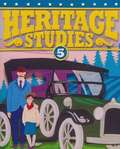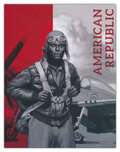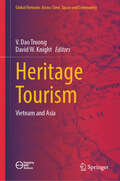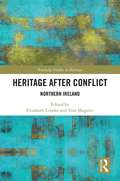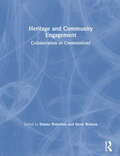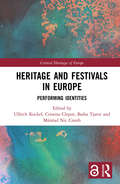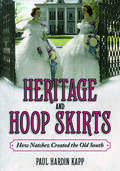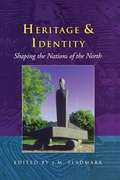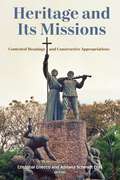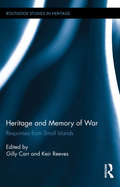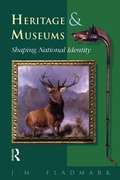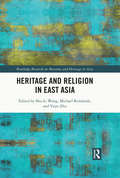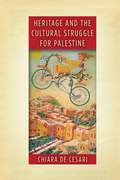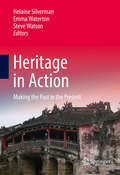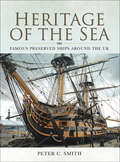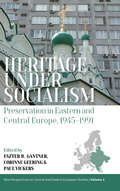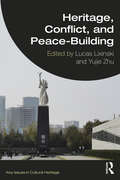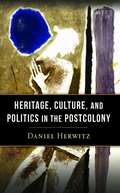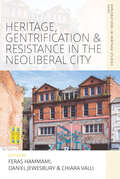- Table View
- List View
Heritage Studies 6 (Third Edition)
by James R. Davis Peggy S. Alier Annittia Jackson Debra White Marnie Batterman Eileen M. BerryTour the lands, peoples, and cultures of ancient civilizations in Africa, Asia, Europe, and the Americas with the all new Heritage Studies 6 Student Text. This will help students learn the history and influences of these peoples on religion and the world today.
Heritage Studies 6 Activity Manual (3rd Edition)
by James R. Davis Peggy S. Alier Annittia Jackson Debra White Marnie Batterman Eileen M. Berry Ann L. Carruthers Laurie Tebbenkamp Dennae WhiteThe American Republic provides students with a survey of the history and heritage of the United States from Christian worldview.
Heritage Studies 6: Ancient Civilizations Activity Manual
by Bju PressHeritage Studies Grade 6, Ancient Civilizations Activity Manual, Fourth Edition by BJU Press
Heritage Studies Grade 5 Student Text, Fourth Edition
by Bju PressBJU Press Heritage Studies 5 presents a comprehensive narrative of American history from America’s first people through President Obama’s time in office. Photographs, illustrations, maps, timelines, and notes highlight themes of geography, American history, government, economics, world history, and culture. Topics are presented from a biblical perspective and most chapters have an extended activity, a brief narrative called “How It Was,” and biographies to enhance learning. 512 pages with index and glossary, softcover. Parents may wish to note that this book touches upon gay rights and abortion (from a conservative perspective).
Heritage Studies Grade 8: The American Republic Student Text
by Bju PressHeritage Studies Grade 8: The American Republic Student Text (5th Edition)
Heritage Studies Student Grade 1, Third Edition
by Eileen Berry Gina Bradstreet Ann Larson L. Michelle RosierThe book examines the events from pre-1000 to 1682, covering Columbus, Plymouth, trading, Native Americans and other colonial events through the lens of God's redemptive plan.
Heritage Tourism: Vietnam and Asia (Global Vietnam: Across Time, Space and Community)
by V. Dao Truong David W. KnightThis book provides an overview of research and best practices associated with heritage tourism, with a particular focus on Vietnam, in conversation with heritage tourism in other Asian contexts. These include Iran in the Middle East, Sri Lanka in South Asia, Japan and China in East Asia, Thailand in Southeast Asia, and Brunei and the Philippines in the South Pacific. By delving into crucial questions and challenges relating to cultural innovation, preservation, and authenticity, it offers key lessons for policy-making and theorisation which not only contribute to understanding and improving heritage tourism in Vietnam, specifically, and in Asia more broadly, but also inform efforts to preserve and regenerate both natural and cultural heritage on a global scale. It is relevant to researchers and student communities working within areas of heritage, sustainability, tourism, geography, and in Asian studies.
Heritage Traction on the Main Line
by Fred KerrIn an earlier album titled BR Diesel Locomotives in Preservation Fred Kerr detailed the many classes of BR diesel locomotives that had been preserved and noted that some purchases had been made with the hope of operating them on the national network.The Railways Bill 1993 provided an opportunity for this to happen and this album shows such locomotives at work during the early part of the 21st century up to December 2016. During this period many new train operators entered the market and their early operations used elderly locomotives withdrawn from service by their original operators until their business(es) were established and new locomotives could be bought. On occasion these new companies were prepared to hire preserved locomotives with main line access to service short-term contracts and these, mainly freight, services provided much of the variety of locomotive operations that offset the increasing sight of multiple unit train services that epitomize the modern railway.The author has chosen to consider heritage traction as any locomotive older than twenty years, which therefore includes electric locomotives but excludes those of that age which are still operated by their owners as at April 1 1994 when British Railways (BR) was privatized. This results in the Class 59 fleet being excluded because its ownership has been constant but the Class 60 fleet being included because of purchases by Colas Railfreight after that date.
Heritage after Conflict: Northern Ireland
by Thomas Maguire Elizabeth CrookeThe year 2018 marks the twentieth anniversary of the signing of the Belfast Agreement that initiated an uneasy peace in Northern Ireland after the forty years of the Troubles. The last twenty years, however, has still not been sufficient time to satisfactorily resolve the issue of how to deal with the events of the conflict and the dissonant heritages that both gave rise to it and were, in turn, fuelled by it. With contributions from across the UK and Europe, Heritage after Conflict brings together a range of expertise to examine the work to which heritage is currently being put within Northern Ireland. Questions about the contemporary application of remembering infiltrate every aspect of heritage studies, including built heritages, urban regeneration and planning, tourism, museum provision and intangible cultural heritages. These represent challenges for heritage professionals, who must carefully consider how they might curate and conserve dissonant heritages without exacerbating political tensions that might spark violence. Through a lens of critical heritage studies, contributors to this book locate their work within the wider contexts of post-conflict societies, divided cities and dissonant heritages. Heritage after Conflict should be essential reading for academics, researchers and postgraduate students engaged in the study of the social sciences, history, peace studies, economics, cultural geography, museum heritage and cultural policy, and the creative arts. It should also be of great interest to heritage professionals.
Heritage and Community Engagement: Collaboration Or Contestation?
by Emma Waterton Steve WatsonThis book is about the way that professionals in archaeology and in other sectors of heritage interact with a range of stakeholder groups, communities and the wider public. Whilst these issues have been researched and discussed over many years and in many geographical contexts, the debate seems to have settled into a comfortable stasis wherein it is assumed that all that can be done by way of engagement has been done and there is little left to achieve. In some cases, such engagement is built on legislation or codes of ethics and there can be little doubt that it is an important and significant aspect of heritage policy. This book is different, however, because it questions not so much the motivations of heritage professionals but the nature of the engagement itself, the extent to which this is collaborative or contested and the implications this has for the communities concerned. Furthermore, in exploring these issues in a variety of contexts around the world, it recognises that heritage provides a source of engagement within communities that is separate from professional discourse and can thus enable them to find voices of their own in the political processes that concern them and affect their development, identity and well-being. This book was published as a special issue of the International Journal of Heritage Studies.
Heritage and Festivals in Europe: Performing Identities (Critical Heritages of Europe)
by Ullrich Kockel Máiréad Nic Craith Cristina Clopot Baiba TjarveHeritage and Festivals in Europe critically investigates the purpose, reach and effects of heritage festivals. Providing a comprehensive and detailed analysis of comparatively selected aspects of intangible cultural heritage, the volume demonstrates how such heritage is mobilised within events that have specific agency, particularly in the production and consumption of intrinsic and instrumental benefits for tourists, local communities and performers. Bringing together experts from a wide range of disciplines, the volume presents case studies from across Europe that consider many different varieties of heritage festivals. Focusing primarily on the popular and institutional practices of heritage making, the book addresses the gap between discourses of heritage at an official level and cultural practice at the local and regional level. Contributors to the volume also study the different factors influencing the sustainable development of tradition as part of intangible cultural heritage at the micro- and meso-levels, and examine underlying structures that are common across different countries. Heritage and Festivals in Europe takes a multidisciplinary approach and as such, should be of interest to scholars and students in the fields of heritage studies, tourism, performing arts, cultural studies and identity studies. Policymakers and practitioners throughout Europe should also find much to interest them within the pages of this volume.
Heritage and Hoop Skirts: How Natchez Created the Old South
by Paul Hardin KappWinner of the 2023 John Brinckerhoff Jackson Book PrizeWinner of the 2023 UMW Center for Historic Preservation Book PrizeWinner of the 2023 Fred B. Kniffen Award from the International Society for Landscape, Place, & Material CultureWinner of the 2023 Michael V. R. Thomason Book Award from the Gulf South Historical AssociationFor over eighty years, tourists have flocked to Natchez, Mississippi, seeking the “Old South,” but what they encounter is invention: a pageant and rewrite of history first concocted during the Great Depression. In Heritage and Hoop Skirts: How Natchez Created the Old South, author Paul Hardin Kapp reveals how the women of the Natchez Garden Club saved their city, created one of the first cultural tourism economies in the United States, changed the Mississippi landscape through historic preservation, and fashioned elements of the Lost Cause into an industry. Beginning with the first Natchez Spring Pilgrimage of Antebellum Homes in 1932, such women as Katherine Grafton Miller, Roane Fleming Byrnes, and Edith Wyatt Moore challenged the notion that smokestack industries were key to Natchez’s prosperity. These women developed a narrative of graceful living and aristocratic gentlepeople centered on grand but decaying mansions. In crafting this pageantry, they created a tourism magnet based on the antebellum architecture of Natchez. Through their determination and political guile, they enlisted New Deal programs, such as the WPA Writers’ Project and the Historic American Buildings Survey, to promote their version of the city. Their work did save numerous historic buildings and employed both white and African American workers during the Depression. Still, the transformation of Natchez into a tourist draw came at a racial cost and further marginalized African American Natchezians. By attending to the history of preservation in Natchez, Kapp draws on a rich archive of images, architectural documents, and popular culture to explore how meaning is assigned to place and how meaning evolves over time. In showing how and why the Natchez buildings of the “Old South” were first preserved, commercialized, and transformed into a brand, this volume makes a much-needed contribution to ongoing debates over the meaning attached to cultural patrimony.
Heritage and Identity
by Thor Heyerdahl J. M. FladmarkWas the shaping of nation states in Northern Europe governed by military might, or by Christian and democratic ideals? How has trade and cross-cultural exchange between Scandinavia and the British Isles shaped our historic identities, and what about the impact of global politics and marketing in recent times? These are some of the questions explored by the contributors in the context of forces that shape national identities today. Their analysis highlights the need for historical awareness when developing future cultural policy, brand profiles and marketing strategies. Looking back, Jesse Byock tells how democracy was first embraced in the north by the early settlers of Iceland, Bjorn Myhre delves into the unpredictability of historical interpretation, Edward Cowan discusses the role of 'battles and beddings' in relations across the North Sea, John Purkis writes about William Morris' fascination with Nordic culture, Stephen Harrison presents the 'winning ways' of product development and marketing by Manx National Heritage, whilst Chris Powell looks at 'Cool Britannia' today and Simon Anholt at national branding strategies. This is an inspirational book that sheds new light on old subjects, equally relevant for both public and private sector policy makers alike.
Heritage and Its Missions: Contested Meanings and Constructive Appropriations (Catholic Practice in the Americas)
by Cristóbal Gnecco and Adriana Schmidt DiasExplores how heritage discourses and local publics interact at Catholic mission sites in the southwestern United States, northern Mexico, and the Southern ConeInterdisciplinary in scope and classed under the name “critical heritage studies,” Heritage and Its Missions makes extensive use of ethnographic perspectives to examine heritage not as a collection of inert things upon which a general historical interest is centered, but as a series of active meanings that have consequences in the social, political, and economic arenas. This approach considers the places of interaction between heritage discourses and local publics as constructed spaces where the very materiality of the social and the political unfolds.Heritage and Its Missions brings together researchers from several countries interested in the pre-republican Catholic missions in the Americas as heritage. Each essay discusses the past and current heritage meanings applied to a specific mission by national and multicultural states, local Indigenous and non-Indigenous communities, international heritage institutions, and scholars. They then address how heritage actors produce knowledge from their positioned perspectives; how different actors, collectives, communities, and publics relate to them; how heritage representations are deployed and contested as social facts; and how different conceptions of “heritage” collide, collaborate, and intersperse to produce the meanings around which heritage struggles unfold.
Heritage and Memory of War: Responses from Small Islands (Contributions To Global Historical Archaeology #1)
by Gilly Carr Keir ReevesEvery large nation in the world was directly or indirectly affected by the impact of war during the course of the twentieth century, and while the historical narratives of war of these nations are well known, far less is understood about how small islands coped. These islands – often not nations in their own right but small outposts of other kingdoms, countries, and nations – have been relegated to mere footnotes in history and heritage studies as interesting case studies or unimportant curiosities. Yet for many of these small islands, war had an enduring impact on their history, memory, intangible heritage and future cultural practices, leaving a legacy that demanded some form of local response. This is the first comprehensive volume dedicated to what the memories, legacies and heritage of war in small islands can teach those who live outside them, through closely related historical and contemporary case studies covering 20th and 21st century conflict across the globe. The volume investigates a number of important questions: Why and how is war memory so enduring in small islands? Do factors such as population size, island size, isolation or geography have any impact? Do close ties of kinship and group identity enable collective memories to shape identity and its resulting war-related heritage? This book contributes to heritage and memory studies and to conflict and historical archaeology by providing a globally wide-ranging comparative assessment of small islands and their experiences of war. Heritage of War in Small Island Territories is of relevance to students, researchers, heritage and tourism professionals, local governments, and NGOs.
Heritage and Museums
by J. M. FladmarkPapers from the 1999 conference by the Museum of Scotland. Aims to generate international comparison and debate about interpretation and presentation of heritage assets, and to examine the role of museums in shaping national identity.
Heritage and Religion in East Asia (Routledge Research on Museums and Heritage in Asia)
by Yujie Zhu Michael Rowlands Shu-Li WangHeritage and Religion in East Asia examines how religious heritage, in a mobile way, plays across national boundaries in East Asia and, in doing so, the book provides new theoretical insights into the articulation of heritage and religion. Drawing on primary, comparative research carried out in four East Asian countries, much of which was undertaken by East Asian scholars, the book shows how the inscription of religious items as "Heritage" has stimulated cross-border interactions among religious practitioners and boosted tourism along modern pilgrimage routes. Considering how these forces encourage cross-border links in heritage practices and religious movements in China, Taiwan, South Korea, and Japan, the volume also questions what role heritage plays in a region where Buddhism, Taoism, and other various folk religious practices are dominant. Arguing that it is diversity and vibrancy that makes religious discourse in East Asia unique, the contributors explore how this particularity both energizes and is empowered by heritage practices in East Asia. Heritage and Religion in East Asia enriches understanding of the impact of heritage and religious culture in modern society and will be of interest to academics and students working in heritage studies, anthropology, religion, and East Asian studies.
Heritage and the Cultural Struggle for Palestine (Stanford Studies in Middle Eastern and Islamic Societies and Cultures)
by Chiara De CesariIn recent decades, Palestinian heritage organizations have launched numerous urban regeneration and museum projects across the West Bank in response to the enduring Israeli occupation. These efforts to reclaim and assert Palestinian heritage differ significantly from the typical global cultural project: here it is people's cultural memory and living environment, rather than ancient history and archaeology, that take center stage. It is local civil society and NGOs, not state actors, who are "doing" heritage. In this context, Palestinian heritage has become not just a practice of resistance, but a resourceful mode of governing the Palestinian landscape. With this book, Chiara De Cesari examines these Palestinian heritage projects—notably the Hebron Rehabilitation Committee, Riwaq, and the Palestinian Museum—and the transnational actors, practices, and material sites they mobilize to create new institutions in the absence of a sovereign state. Through their rehabilitation of Palestinian heritage, these organizations have halted the expansion of Israeli settlements. They have also given Palestinians opportunities to rethink and transform state functions. Heritage and the Cultural Struggle for Palestine reveals how the West Bank is home to creative experimentation, insurgent agencies, and resourceful attempts to reverse colonial violence—and a model of how things could be.
Heritage in Action
by Helaine Silverman Emma Waterton Steve WatsonIn this textbook we see heritage in action in indigenous and vernacular communities, in urban development and regeneration schemes, in expressions of community, in acts of nostalgia and memorialization and counteracts of forgetting, in museums and other spaces of representation, in tourism, in the offices of those making public policy, and in the politics of identity and claims toward cultural property. Whether renowned or local, tangible or intangible, the entire heritage enterprise, at whatever scale, is by now inextricably embedded in "value". The global context requires a sanguine approach to heritage in which the so-called critical stance is not just theorized in a rarefied sphere of scholarly lexical gymnastics, but practically engaged and seen to be doing things in the world.
Heritage of the Sea: Famous Preserved Ships around the UK
by Peter C. SmithThe 21st century saw the naval power of Great Britain rise from that of an obscure island to that of a world-wide empire. British shipping and seamen dominated the globe for four centuries and the ships that explored the world and those which guarded them represent a unique treasure-trove of maritime history, unrivaled anywhere in the world. This book serves as an enthralling trawl through the heritage of the British shipping tradition, featuring images of iconic ships which have been preserved for all of us to marvel at. Each ship has a chapter dedicated to it, featuring a potted history and details of it's current location. A book which stirs a real desire to tour the sites it describes, it features full colour illustrations throughout, each of them evoking pride and diversity and inviting further study. Among the many vessels analysed and illustrated are HMS VICTORY, HMS WARRIOR, HMS CAVALIER, HMS BELFAST, HMS CAROLINE, HMS WELLINGTON, HMS ALIANCE, HMS TRINCOMALEE; the CHRYSANTHEMUM & PRESIDENT; the Royal Yacht BRITANNIA; the CUTTY SARK; the DISCOVERY; GYPSY MOTH II; GREAT BRITAIN; the MEDWAY QUEEN; the GANNET; the UNICORN; the CAMBRIA and many more.
Heritage under Socialism: Preservation in Eastern and Central Europe, 1945–1991 (New Perspectives on Central and Eastern European Studies #2)
by Eszter Gantner, Corinne Geering, and Paul VickersHow was heritage understood and implemented in European socialist states after World War II? By exploring national and regional specificities within the broader context of internationalization, this volume enriches the conceptual, methodological and empirical scope of heritage studies through a series of fascinating case studies. Its transnational approach highlights the socialist world’s diverse interpretations of heritage and the ways in which they have shaped the trajectories of present-day preservation practices.
Heritage under Socialism: Preservation in Eastern and Central Europe, 1945–1991 (New Perspectives on Central and Eastern European Studies #2)
by Eszter Gantner, Corinne Geering, and Paul VickersHow was heritage understood and implemented in European socialist states after World War II? By exploring national and regional specificities within the broader context of internationalization, this volume enriches the conceptual, methodological and empirical scope of heritage studies through a series of fascinating case studies. Its transnational approach highlights the socialist world’s diverse interpretations of heritage and the ways in which they have shaped the trajectories of present-day preservation practices.
Heritage, Conflict, and Peace-Building (ISSN)
by Lucas Lixinski Yujie ZhuHeritage, Conflict, and Peace-Building examines the possibilities arising from, and challenges associated with, transforming heritage from a casualty of conflict into an opportunity for peacebuilding.The contributors to this book, who hail from academia and practice, present case studies that shed light on the multifaceted factors and conditions influenced by diplomacy, nationalism, victimhood, and the roles of diverse institutional actors in fostering peace. They demonstrate the possibilities and pitfalls of the work heritage does for local communities, the nation-state, and the international community, when these different actors and their peace aspirations and agendas intersect. Looking at heritage and peace processes on all continents, the contributions in this volume amount to a compelling analytical account of how the discourses of heritage and peace connect, overlap, and diverge. They also emphasise that our shared aspiration for peace should not be taken for granted in a heritage context, and that it is incumbent upon heritage scholars and practitioners to be more intentional about the work they wish to do to promote peace.Heritage, Conflict, and Peace-Building will be of interest to scholars and practitioners working in heritage studies, transitional justice, museum studies, international relations, education, history, and law.
Heritage, Culture, and Politics in the Postcolony
by Daniel HerwitzThe act of remaking one's history into a heritage, a conscientiously crafted narrative placed over the past, is a thriving industry in almost every postcolonial culture. This is surprising, given the tainted role of heritage in so much of colonialism's history. Yet the postcolonial state, like its European predecessor of the eighteenth and nineteenth centuries, deploys heritage institutions and instruments, museums, courts of law, and universities to empower itself with unity, longevity, exaltation of value, origin, and destiny. Bringing the eye of a philosopher, the pen of an essayist, and the experience of a public intellectual to the study of heritage, Daniel Herwitz reveals the febrile pitch at which heritage is staked. In this absorbing book, he travels to South Africa and unpacks its controversial and robust confrontations with the colonial and apartheid past. He visits India and reads in its modern art the gesture of a newly minted heritage idealizing the precolonial world as the source of Indian modernity. He traverses the United States and finds in its heritage of incessant invention, small town exceptionalism, and settler destiny a key to contemporary American media-driven politics. Showing how destabilizing, ambivalent, and potentially dangerous heritage is as a producer of contemporary social, aesthetic, and political realities, Herwitz captures its perfect embodiment of the struggle to seize culture and society at moments of profound social change.
Heritage, Gentrification and Resistance in the Neoliberal City (Explorations in Heritage Studies #5)
by Chiara Valli Feras Hammami, Daniel JewesburyWhat happens when versions of the past become silenced, suppressed, or privileged due to urban restructuring? In what ways are the interpretations and performances of ‘the past’ linked to urban gentrification, marginalization, displacement, and social responses? Authors explore a variety of attempts to interrupt and interrogate urban restructuring, and to imagine alternative forms of urban organization, produced by diverse coalitions of resisting groups and individuals. Armed with historical narratives, oral histories, objects, physical built environment, memorials, and intangible aspects of heritage that include traditions, local knowledge and experiences, memories, authors challenge the ‘devaluation’ of their neighborhoods in official heritage and development narratives.

